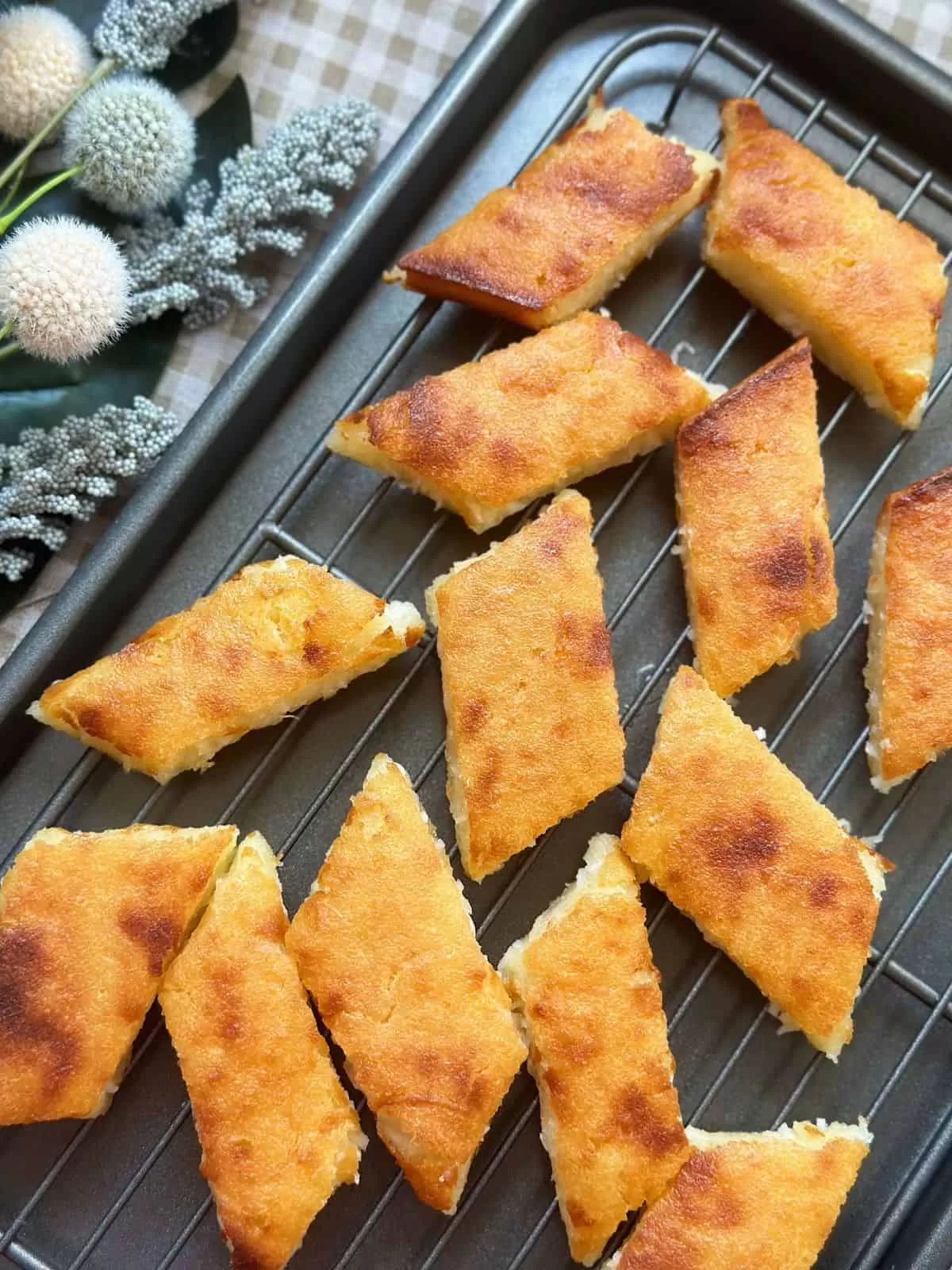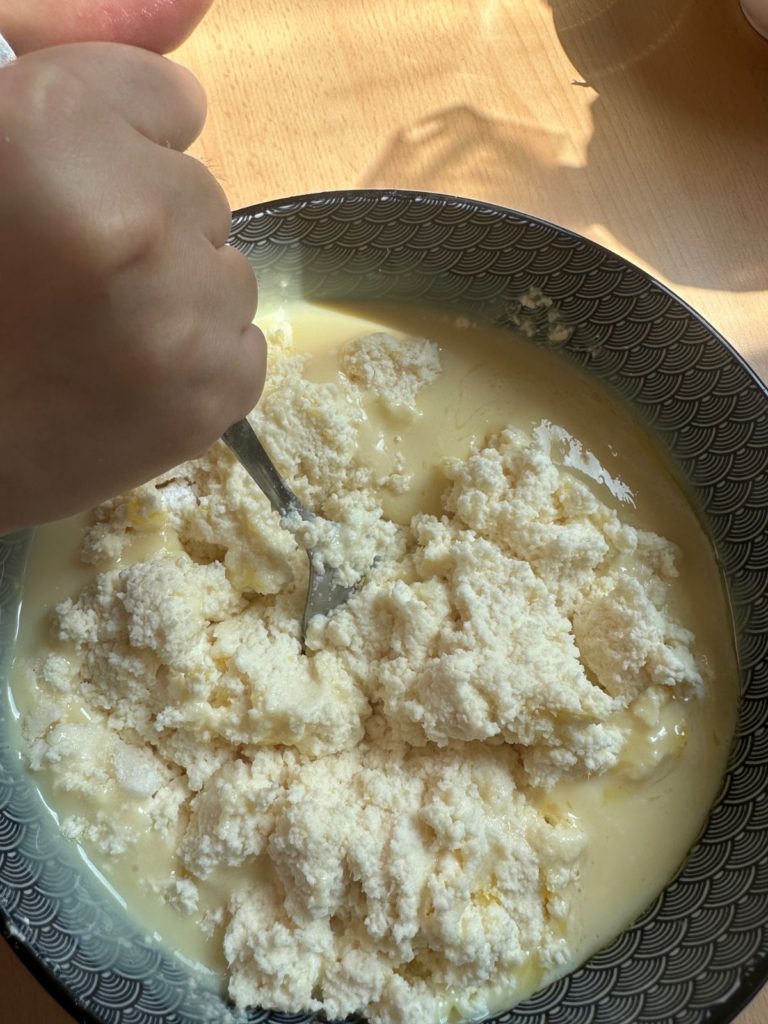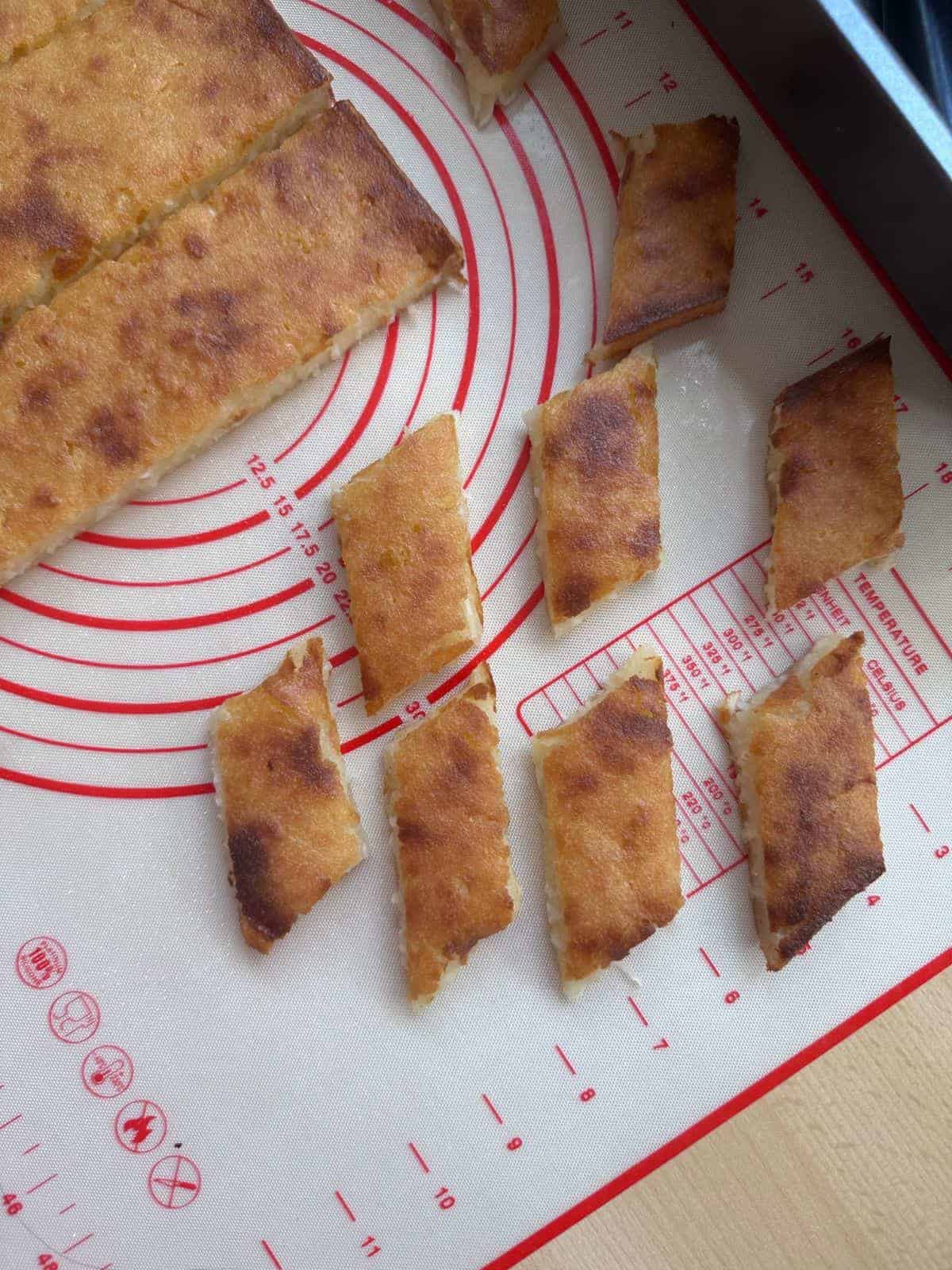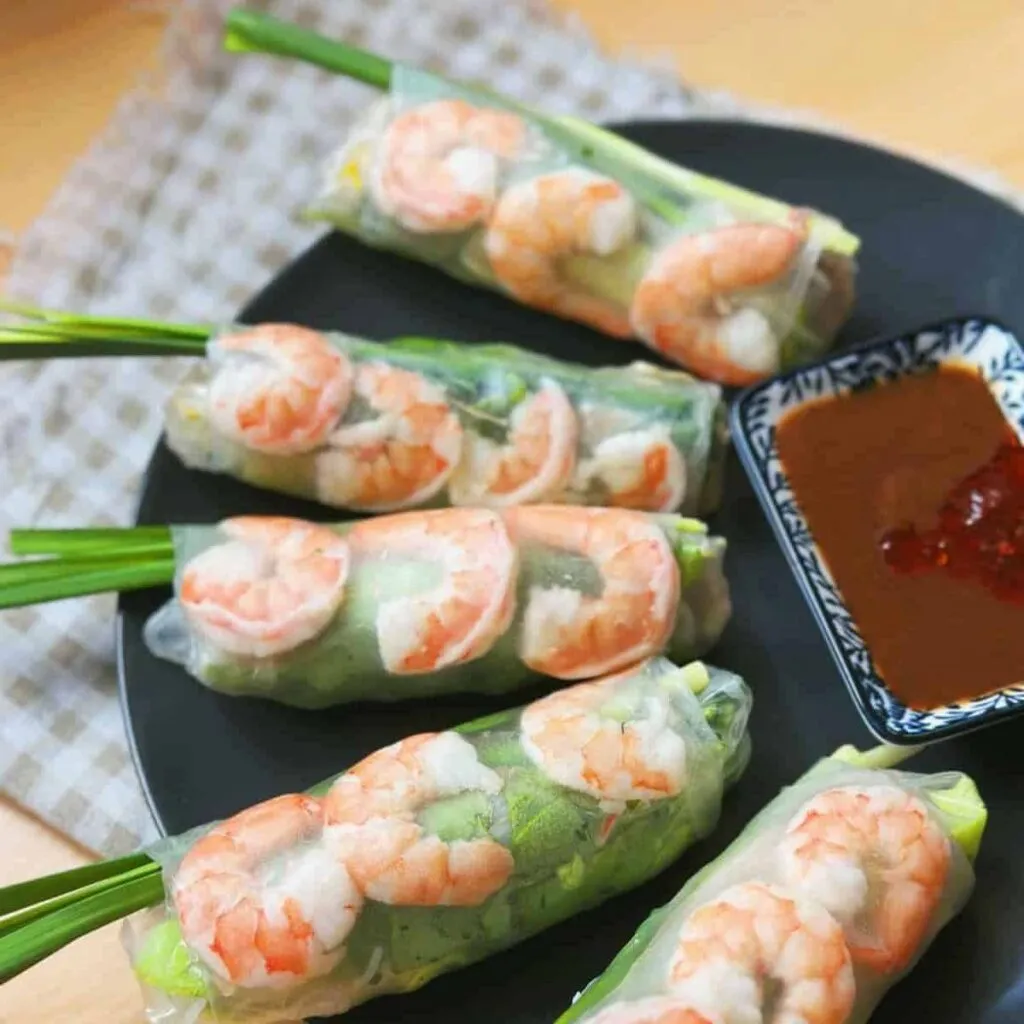Vietnamese Cassava Cake (Bánh Khoai Mì Nướng) is a nostalgic delight from my childhood, cherished for its rich blend of coconut milk and condensed milk. Its appeal lies in the contrast between a crispy exterior and a chewy, mochi-like interior.

Table of Contents
Bánh Khoai Mì Nướng (Vietnamese Cassava Cake)
Bánh Khoai Mì Nướng is a well-loved dessert in Southern Vietnam, alongside other favorites such as Bánh Kẹp Lá Dứa (Pandan Waffles), Bánh Chuối Nướng (Baked Banana Cake), and Bánh Bò Nướng Lá Dứa (Pandan Honeycomb Cake).

This cassava cake is rich with the creamy flavor of coconut milk, sure to please coconut fans.
In Vietnam, traditionally, coconut cassava cake is made using fresh cassava, which needs to be peeled and grated. But in my recipe, I simplify it by using frozen grated cassava.
In South East Asia, there are numerous variations of cassava cake such as the Filipino Cassava Bibingka (featuring a delicious custard topping) or the Indonesian Kuih Bingka Ubi Kayu with a subtle nuance.
What is Cassava?

Cassava (“Yuca” / “Manioc” and known as “Khoai Mì “/ “Củ Sắn” in Vietnamese) is a root vegetable that holds popularity in Southeast Asian, Latin American, and Caribbean cuisines.
This veggie offers numerous health benefits, particularly its high vitamin C content.
However, consuming raw cassava is not recommended because it contains natural cyanide, which can be harmful when ingested. To safely enjoy cassava, soaking and cooking it thoroughly to remove this toxin.
Ingredients

- Frozen Grated Cassava: This ingredient is readily available at Asian markets or Mexican markets, and it’s the key component for this recipe.
- Sweetened Condensed Milk: A rich and sweet ingredient that adds depth and sweetness to the cake. It is a popular ingredient in Vietnamese desserts and drinks, such as Vietnamese Flan, Vietnamese Coffee, and Egg Coffee.
- Coconut Milk: This contributes a delightful coconut flavor and creaminess to the cake.
- Vanilla Sugar or Vanilla Extract: Adding a touch of vanilla enhances the overall flavor of the cake.
- Tapioca Starch: Helps bind the ingredients together.
- Melted Butter: melted butter brings the buttery goodness to the cake.
- Shredded Coconut (Optional but Highly Recommended): some coconut meat will add extra texture and a burst of coconut flavor.
- Salt: A pinch of salt enhances the flavors and balances the sweetness of the cake.
Instructions
Prepare the Batter
- Begin by thawing the frozen cassava. If your cassava has a high water content, you can gently squeeze out the excess water.
- In a large bowl, combine the grated cassava, condensed milk, coconut milk, tapioca starch, melted butter, salt, and vanilla sugar. Mix thoroughly until all ingredients are well incorporated.
- Add the coconut meat and mix to combine.
- Allow the batter to rest for 15-30 minutes. While waiting, preheat your oven to 375°F (190°C).


Bake the Cake
- Grease a nonstick pan generously with butter.
- Pour the prepared batter into the pan.
- Bake the cake for 50 – 60 minutes on the lowest oven rack level.
- After around 50 minutes, check if the edges of the cake have turned golden brown. To test for doneness, carefully insert a wooden toothpick into the center of the cake. If it comes out clean, the cake is ready.
- Now, move the cake to the highest oven rack level. Increase the oven temperature to 400°F (205°C) and broil for about 5 minutes, or until the center of the cassava cake achieves a golden hue. Keep a close eye on this stage.


Serve
- Once the cassava cake is fully baked, allow it to cool completely.
- Gently use a knife to cut the cake into parallelogram-shaped pieces. Due to its stickiness, you could lightly grease the knife with butter before cutting.


Helpful Tips
- Use a large square or rectangular pan to bake the Vietnamese Coconut Cassava Cake. The thinner the cake, the crispier the outer layer will be.
- You can store Bánh Khoai Mì Nướng at room temperature for a day. For extended storage, keep it in the fridge for up to 3 days or in the freezer for 3 months. Warm it before serving.
- My recipe yields a generous portion of Cassava cake for 4-5 individuals. If you’re preparing it for a smaller group, you can easily reduce the quantities by half.
- For the vegan version, switch out regular condensed milk for vegan condensed milk and butter for vegan butter.

More Vietnamese snacks you can easily make at home




Vietnamese Cassava Cake (Bánh Khoai Mì Nướng)
Equipment
- 1 big mixing bowl
- 1 large spoon
- 1 large square or rectangular pan (The dimensions of my pan are 16''x 12'' or 41*31cm)
Ingredients
- 2 pound frozen grated Cassava (900g – 1kg)
- 1 can sweetened condensed milk (14oz or 400g)
- 1 can coconut milk (13.5oz or 400ml)
- 2 cup shredded coconut meat (160-170g)
- 1 sachet vanilla sugar (or 2tsp vanilla extract)
- 2 tbsp tapioca starch
- 2 tbsp melted butter (30g)
- ¼ tsp salt
Instructions
Prepare the cassava batter:
- Start by thawing the frozen cassava. If your cassava has a high water content, you can gently squeeze out the extra moisture.
- In a large bowl, add the grated cassava, condensed milk, coconut milk, tapioca starch, melted butter, salt, and vanilla sugar. Combine thoroughly all ingredients. Add the coconut meat and mix well.
- Let the batter sit for 15-30 minutes. During waiting, preheat your oven to 375°F (190°C).
Bake the cassava cake:
- Grease a nonstick pan with butter. Pour the batter into the pan.
- Bake the cassava cake for about 50 – 60 minutes on the lowest oven rack.
- After 50 minutes, check if the edges of the cake have turned golden brown. To check if it's fully cooked, insert a wooden toothpick into the center of the cake. If it comes out clean, the cake is ready.
- Now, move your cake to the top oven rack. Raise the oven temperature to 400°F (205°C) and broil for about 5 minutes, or until the center of the cake get a golden hue. Keep a close eye on this period.
Serve:
- Once the cassava cake is done, let it cool completely.
- Use a knife to cut the cake into parallelogram-shaped pieces. It would be a bit sticky so you could grease the knife with some butter before cutting.
Notes
- Use a large pan for baking since thin cakes have crispier edges (yummier, of course).
- Bánh Khoai Mì Nướng can stay at room temp for a day or be refrigerated for 3 days, or frozen for 3 months – reheat before serving.
- My recipe makes 4-5 servings. Halve it for a smaller group.
-
For a vegan version, use vegan condensed milk and vegan butter.




Hey kann man auch Maniokmehl verwenden und wenn ja wie viel? Auch einfach 1kg?
Ich habe noch nie versucht, diesen Kuchen mit Maniokmehl zu backen. Maniokmehl hat einen geringeren Wassergehalt als gefrorener Maniok, daher empfehle ich, 600-700 g Maniokmehl zu verwenden. Nach dem Mischen kannst du mehr hinzufügen, um die auf meinem Foto gezeigte Teigkonsistenz zu erreichen.
Danke dir erstmal für die schnelle und hilfreiche Antwort. Glaubst du, es macht geschmacklich einen Unterschied?
Ich bin ziemlich sicher, dass der Kuchen besser wird, wenn man gefrorenen Maniok verwendet, da wir in Vietnam entweder gefrorenen oder frischen Maniok für diesen Kuchen benutzen :).
Ich würde den gefrorenen Maniok bestellen. Kann ich den ein paar Tage noch im Gefrierfach lassen, bevor ich den verwerte?
Ja, du kannst gefrorenen Maniok mehrere Monate im Gefrierschrank aufbewahren.
Achso und kann ich auch Kokosraspeln anstatt geschreddertes Kokosfleisch verwenden?
Kokosraspeln sind wesentlich trockener als Kokosnussfleisch. Du musst zwar mehr Flüssigkeit hinzufügen, aber du kannst den Kuchen auch ohne Kokosnussfleisch zubereiten.
Danke und wie lange lässt du den Kuchen abkühlen?
Du könntest den Kuchen für 3-4 Stunden bei Raumtemperatur stehen lassen, um ihn abzukühlen. Danach könntest du ihn für 5 Tage im Kühlschrank aufbewahren.
Echt so lange? 😮 Aber wird schon stimmen, wenn du das sagst 🙂
Wie lange braucht der Maniok, um aufzutauen? Und den Ofen auf Umluft oder Ober/Unterhitze einstellen?
Der Maniok wird wahrscheinlich 1-2 Stunden benötigen, um vollständig aufzutauen. Verwende zum Backen des Kuchens Ober- und Unterhitze (ohne Umluft). Am Ende den Kuchen nur noch mit Oberhitze überbacken :).
Dankeschön und eine letzte Frage noch: Welche Backform benutzt du? Also wie groß ist die oder vlt. kannst du einen Link hier einfügen:)
Du bist immer willkommen. Die Größe meiner Backform beträgt 40*30 cm. Meine Backform gehört zu den stapelbaren Backformen von MasterClass (der erste Link), aber sie sind derzeit nicht im Angebot. Alternativ kannst du die 40*30 cm Backform über den zweiten Link kaufen 🙂 (beide sind Affiliate-Links).
MasterClass Backformen: https://amzn.to/4bYXh32
40*30 Backformen: https://amzn.to/49Bvynw
Danke dir. Und müssen die Stücke dann parallelogrammförmig sein?
In Vietnam schneiden wir den Kuchen oft auf diese Weise, aber es ist nicht erforderlich, ihn in ein Parallelogramm zu schneiden. 🙂
Alles klar. Stellst du den Kuchen auf ein Backblech oder Rost?
Ich ließ es auf dem Backblech abkühlen :).
Gibt es zu der Tapiokastärke eine Alternative und ja wenn welche?
Du könntest stattdessen Kartoffelstärke, Maisstärke oder Mehl verwenden.